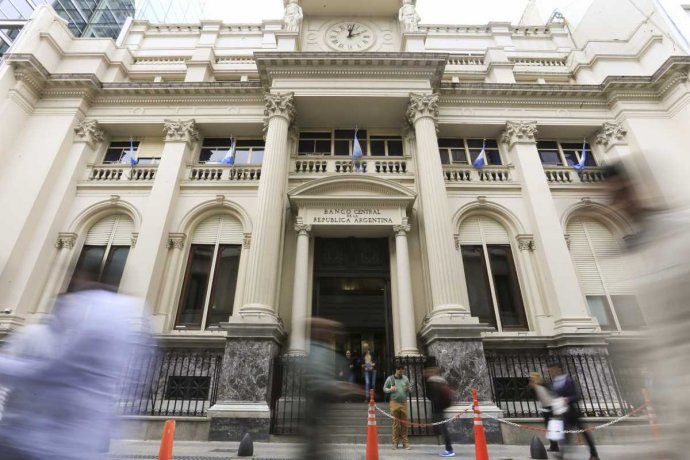The wholesale dollar, meanwhile, advanced 17 cents, to 124.88 pesos, increased 21.6% so far this year and the gap with the blue dollar reached 89.8 percent. Financial exchange rates also hit record highs, as the liquidation counted dollar climbed 2.9% to trade at $253.35 and the MEP or stock dollar rose 2.6% to $247.57.
In the provinces, the increase in blue was greater, since in Santa Cruz and Tierra del Fuego it reached an unprecedented $242, the highest value in the entire country, while in Buenos Aires, Córdoba, Santa Fe and Salta it was sold at $241 , based on marginal foreign exchange market quotes.
Why is the blue dollar going up?
The increases occur in a climate of high financial tension after the Central Bank (BCRA) tightened the exchange rate clamp on companies to stop the bleeding of reserves, but the measures of the monetary authority seem to have no effect.
The president of the BCRA, Miguel Ángel Pesce, affirmed that “any speculative movement moves those references” and pointed out that the rises on the price boards “do not necessarily have to do with the measures we take.” The official explained that “the official market moves 1,000 million dollars a day and the illegal one operates a few million dollars a day,” he added in statements to Urbana Play.
On the other hand, for market specialists, the rise has to do with restricting large companies from accessing the necessary foreign currency to import and forcing them to use their own funds or look for dollars on their own.
They point out that companies that do not have a stock of dollars go to the marginal market to pay for their imports or will have to slow down their level of production, something that can also complicate the level of activity and tax collection.
Causes of the rise in the blue dollar
For the market there are different causes that explain the rise in the blue dollar:
Inflation
After the first spikes of the year, the blue dollar was “frozen” for a few months, causing it to lag behind inflation. The same thing happened with financial dollars. That is, the value was adjusted to the current inflation rate. However, analysts believe that the rise will continue.
Central Bank reserves
Despite the record harvest, the high demand for foreign currency prevents the Central Bank’s reserves from being fed. This was what led the monetary entity to launch actions to contain the “import festival”, as Vice President Cristina Fernández de Kirchner had defined it.
In this context, the Central Bank is unable to buy foreign currency. So far this year it has earned just over $800 million, when in the same period of 2021 it had pocketed $6.5 billion. The reinforced stocks in the face of broad demand leads to part of those pesos going to alternative dollars.
The new restrictions on imports
With the new measures announced this week, which tightened the exchange rate, it redirected the demand for foreign currency towards alternative dollars, such as the blue dollar and the liqui cash, which triggered prices.
The escalation of the counted with liqui
The cash in liquidity (CCL), the dollar that companies have access to, reached $250 on Tuesday. This dollar handles a volume 10 times higher than the blue dollar, which moves about US$5 million daily. And it works as a reference for the informal: when the contado con liqui is fired, the blue follows in its footsteps, although keeping a distance.
“Financial dollars have resumed their upward rearrangement, given that in the context of greater restrictions on imports, the search for coverage is enhanced, a dynamic that could continue to put pressure on the gap as long as these factors remain in force,” he said. the economist Gustavo Ber.
Dollar Blue 6.jpg
What will happen to the blue dollar?
The jump of the blue dollar and the financials generated different opinions and forecasts from analysts. Diego Martínez Burzaco, chief strategist at Inviú, explained that “restricting access to large companies to the foreign currency they need to import into the MULC (Single Free Exchange Market) and forcing them to use their own funds or look for dollars on their own, raises free dollars for a logical reason: companies that do not have a stock of dollars are going to go there to pay for their imports or they will have to slow down their level of production, something that can also complicate the level of activity and tax collection”.
Prior to the day, the analyst Salvador Di Stéfano, one of the most listened to gurus in the City, had already warned about the situation of the dollar, especially the Dolar blueand estimated that it could reach up to $300.
Financial analyst Christian Buteler stressed that “this Monday all the dollars rose and that is going to be the way forward.” And he assured: “Last week you had the BCRA buying CER bonds, which means more pesos on the street. Added to this is now a greater stock. More pesos on the street and a restrictive stock, which will surely give you is a dollar more expensive,” he said. In this framework, the analyst predicted: “I don’t think the movement (of parallel dollars) has ended today, we will probably see it continue to rise in the coming days.”
“How much is it going to go up? The speed that this goes up and how far it goes will depend on the amount of pesos they throw into the street and how much more they tighten the trap. But always, the higher the trap, the higher the price of the dollar. That is something we’ve been seeing for two years,” Buteler said.
dollar-inversions-finances.jpg

pixabay
For his part, Sebastián Menescadi, director of EcoGo, maintained that “the measures limit access to the MULC to a large group of importers and ask them to take some credit abroad to make purchases, particularly those with automatic licenses.” . And he stressed: “They are closing the tap on imports. Given that, the first reaction is to go buy dollars and that is noticeable both in the financial market and in the informal market.”
Aldo Abram, director of the Fundación Libertad y Progreso, pointed out that to the extent that they restrict the official foreign exchange market to importers, “there are many who are going to go look for those currencies in financial dollars, because that way they can buy things in white. abroad to sell them here”.
In turn, Fernando Baer, chief economist at Quantum Finance, stated that “the more restrictions, the greater pressure on dollars that move more freely.” And he warned that “the combination of a fall in the demand for pesos (now boosted by titles in pesos with intervention by the BCRA to try to give them a floor) and these news, on the exchange front, do not help at all”, given the current financial scenario.
With the same view, Emiliano Anselmi, leader of the PPI macroeconomic team, predicted that the financial dollars “have plenty of room to go” with these measures that reinforce the stocks because “there is already an excess of pesos in the economy and the BCRA continues to issue all the days to sustain the CER curve”.
CENTRAL BANK

NA
“The excess of pesos will be more closed to the official channel, so it will tend to go through the parallels (despite the regulations that make participation in both markets exclusive, it will make itself felt),” he argued. The analyst judged that “it is an erroneous measure that only seeks to postpone the fall in reserves, which will end up widening the exchange rate gap.” And he stated that “the only positive measure” for the market in the current context “is a fiscal adjustment and the ruling party is far from wanting to send that signal.”
For his part, the analyst Gustavo Ber agreed that “it is likely that part of the restricted demand will be redirected towards financial dollars, which could lead to an upward resumption that adds to a dynamic of ‘more pesos, less dollars’ towards the second semester.
Economist Federico Glustein said that “it is clear that the rise in dollars this Monday is related to these measures (by the BCRA): the CCL, the MEP and the blue skyrocketed, and it is likely that the upward trend will continue until the market finds a way to act with these new restrictions”.
In turn, Alejandro Giacoia, an economist at EconViews, assessed that “this type of measure clearly goes in the opposite direction of what is needed to reduce the exchange rate gap.” And he pointed out: “The parallel prices went up again, and this level of uncertainty and lack of credibility does not help them to go down.”
Source: Ambito
David William is a talented author who has made a name for himself in the world of writing. He is a professional author who writes on a wide range of topics, from general interest to opinion news. David is currently working as a writer at 24 hours worlds where he brings his unique perspective and in-depth research to his articles, making them both informative and engaging.




